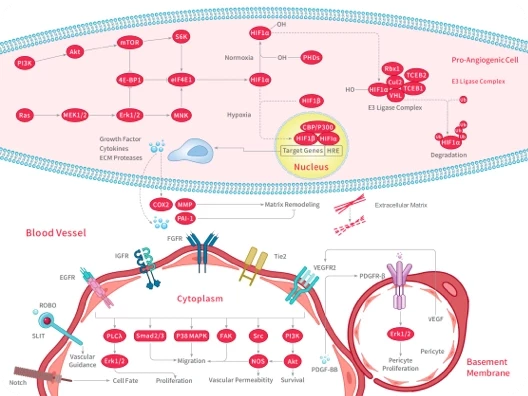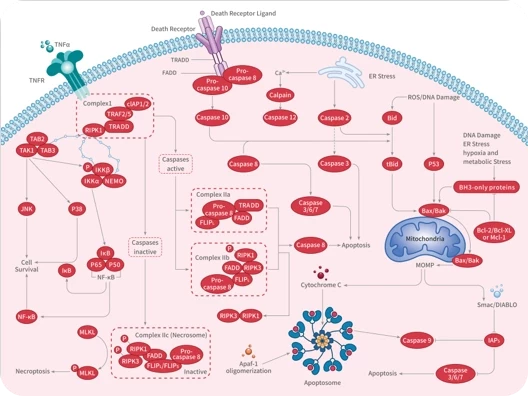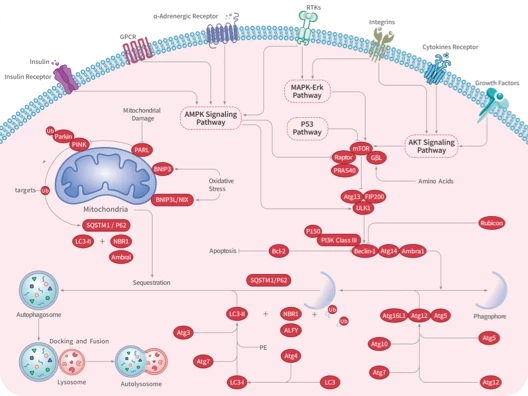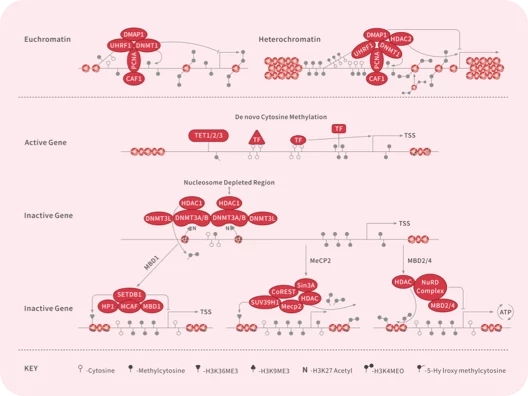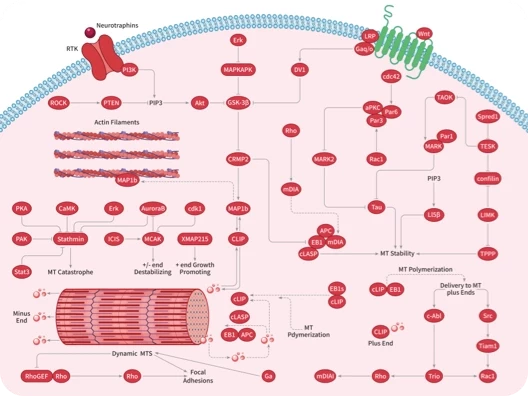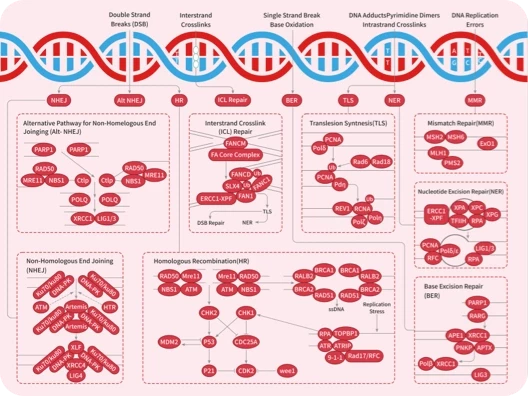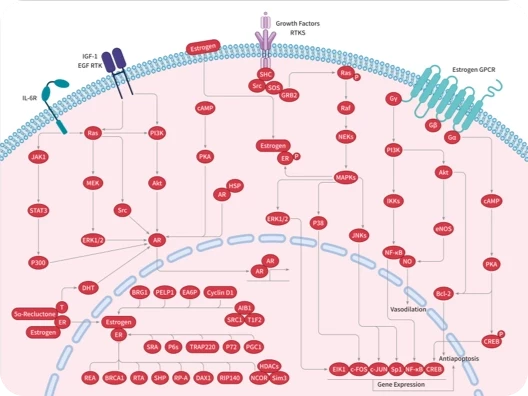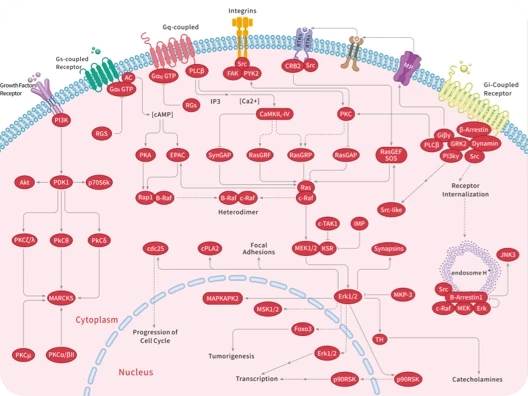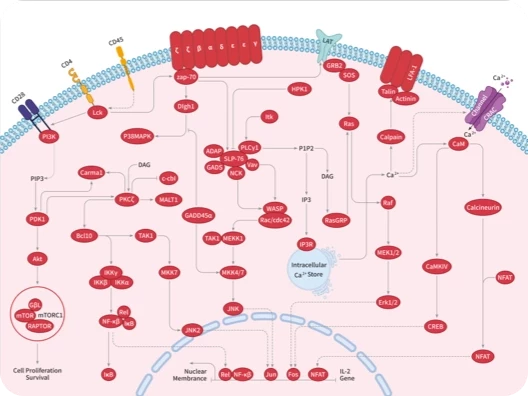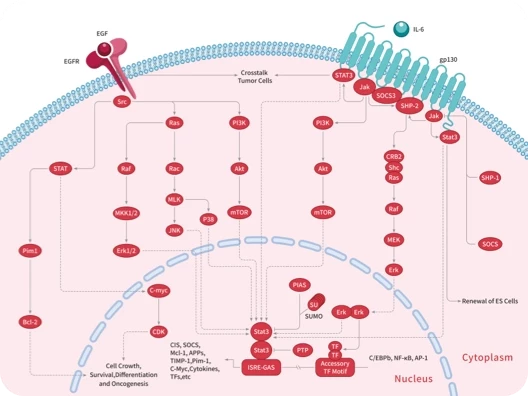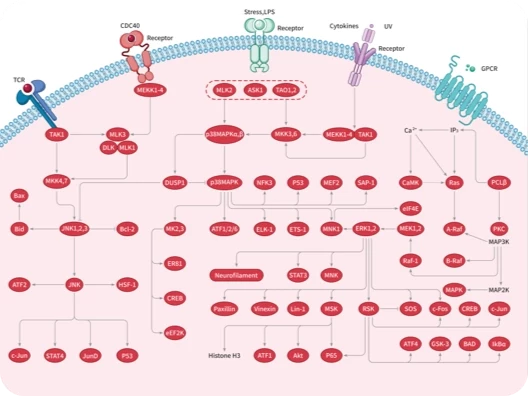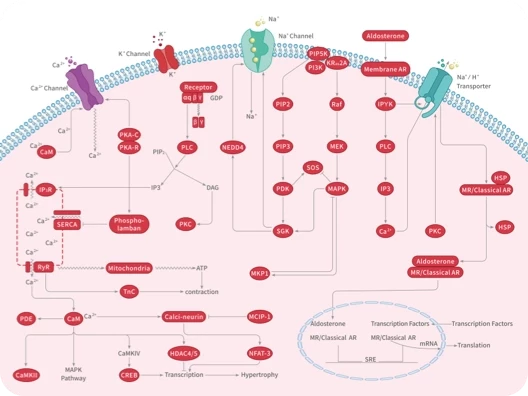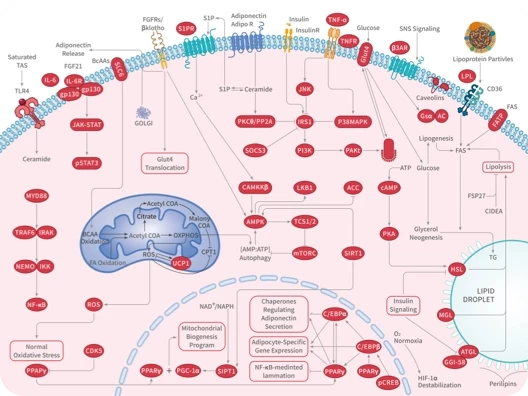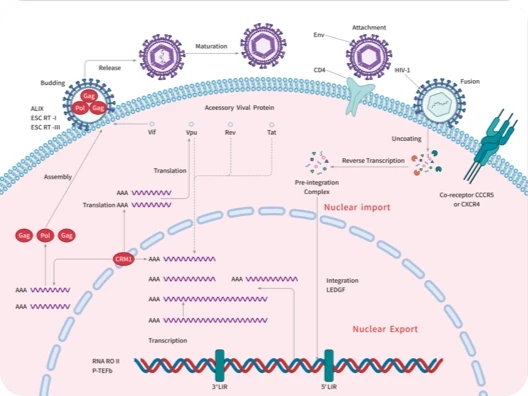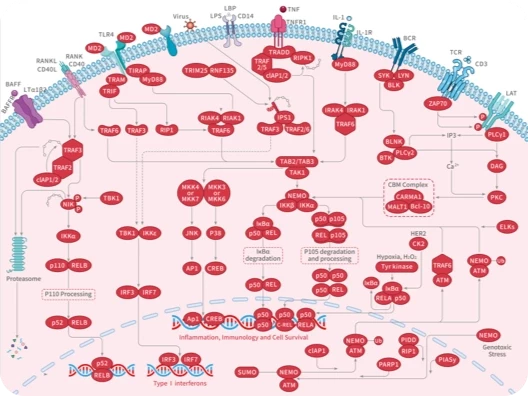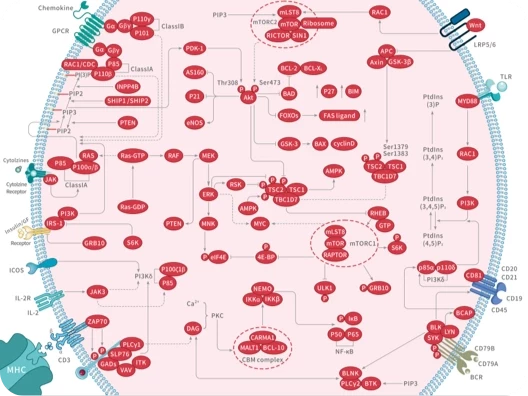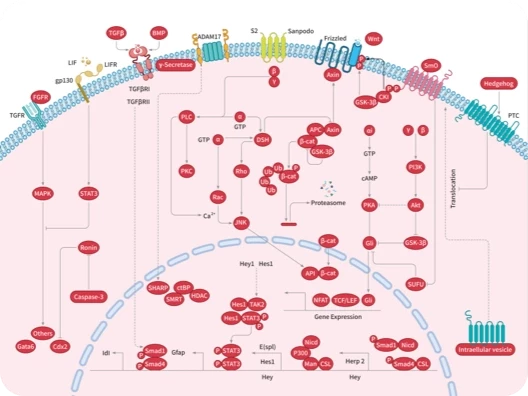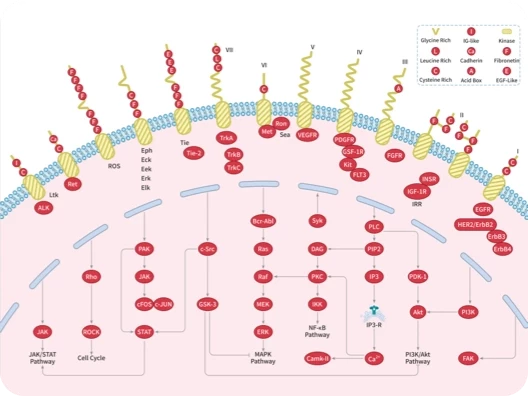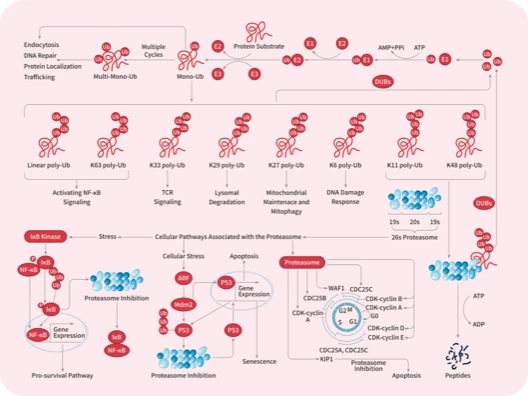- 全部删除
 您的购物车当前为空
您的购物车当前为空
购物车
干扰素受体 (Interferon Receptors)
(28)
白细胞介素受体 (Interleukin Receptors)
(329)
纤维生长因子受体 (Fibroblast Growth Factor Receptors, FGFRs)
(73)
肿瘤坏死因子受体 (Tumor Necrosis Factor Receptors, TNFRs)
(280)
血小板源生长因子受体 (Platelet-Derived Growth Factor Receptors, PDGFRs)
(23)
血管内皮生长因子受体 (Vascular Endothelial Growth Factor Receptors, VEGFRs)
(37)
表皮生长因子受体 (Epidermal Growth Factor Receptors, EGFRs)
(91)
转化生长因子-β 受体 (Transforming Growth Factor-β Receptors, TGF-β Receptors)
(65)
其他 (Others)
(217)
转化生长因子-β 受体 (Transforming Growth Factor-β Receptors, TGF-β Receptors)
转化生长因子-β 受体 (Transforming Growth Factor-β Receptors, TGF-β Receptors) 是属于TGF-β受体家族的单次丝氨酸/苏氨酸激酶受体。它们存在于几种不同的亚型中,可以是同源或异二聚体。TGF-β 是一种参与旁分泌信号传导的生长因子和细胞因子,存在于许多不同的组织类型中,包括大脑、心脏、肾脏、肝脏、骨骼和睾丸。TGF-β的过度表达可诱发肾纤维化,导致肾脏疾病,以及糖尿病,并最终导致终末期肾病。
TGFBR1 Protein, Human, Recombinant (mFc & Avi)
TMPK-00305
transforming growth factor beta receptor 1 (TGFBR1), a key stimulator of tumor proliferation and metastasis, was a direct target of miR‑98‑5p. miR‑98‑5p overexpression resulted in the downregulation of TGFBR1 and the suppression of the viability, proliferation, migration and invasion of A549 and H1299 cells. TGFBR1 Protein, Human, Recombinant (mFc & Avi) is expressed in HEK293 mammalian cells with C-mFc-Avi tag. The predicted molecular weight is 38.2 kDa and the accession number is P36897-1.
- ¥ 3980
规格
数量
TGFBR2 Protein, Human, Recombinant (His)
TMPY-05157
TGFBR2 Protein, Human, Recombinant (His) is expressed in Baculovirus insect cells with His tag. The predicted molecular weight is 17.8 kDa and the accession number is P37173.
- ¥ 3170
规格
数量
BMPR1A/ALK-3 Protein, Canine, Recombinant (hFc)
TMPY-00614
BMPR1A ALK-3 Protein, Canine, Recombinant (hFc) is expressed in HEK293 mammalian cells with hFc tag. The predicted molecular weight is 41.2 kDa and the accession number is A0A8C0S7K5.
- ¥ 2530
规格
数量
ALK-1 Protein, Cynomolgus, Recombinant (His)
TMPY-00310
ALK-1 Protein, Cynomolgus, Recombinant (His) is expressed in HEK293 mammalian cells with His tag. The predicted molecular weight is 12.2 kDa and the accession number is A0A2K5WXU2.
- ¥ 3820
规格
数量
ACVR2B Protein, Cynomolgus, Recombinant (His)
TMPY-03827
ACVR2B Protein, Cynomolgus, Recombinant (His) is expressed in HEK293 mammalian cells with His tag. The predicted molecular weight is 14.8 kDa.
- ¥ 5750
规格
数量
BMPR1A/ALK-3 Protein, Mouse, Recombinant (His & hFc)
TMPY-00962
BMPR1A ALK-3 Protein, Mouse, Recombinant (His & hFc) is expressed in HEK293 mammalian cells with His and hFc tag. The predicted molecular weight is 42 kDa and the accession number is P36895.
- ¥ 4460
规格
数量
ALK-2/ACVR1 Protein, Human, Recombinant (His & hFc)
TMPY-00658
ALK-2 ACVR1 Protein, Human, Recombinant (His & hFc) is expressed in HEK293 mammalian cells with His and hFc tag. The predicted molecular weight is 39.6 kDa and the accession number is D3DPA4.
- ¥ 5750
规格
数量
ALK-4/ACVR1B Protein, Human, Recombinant (His)
TMPY-01293
ALK-4 ACVR1B Protein, Human, Recombinant (His) is expressed in HEK293 mammalian cells with His tag. The predicted molecular weight is 13 kDa and the accession number is P36896-1.
- ¥ 3820
规格
数量
BMPRIB Protein, Human, Recombinant (hFc)
TMPY-03362
BMPRIB Protein, Human, Recombinant (hFc) is expressed in HEK293 mammalian cells with hFc tag. The predicted molecular weight is 39.7 kDa and the accession number is O00238-1.
- ¥ 5750
规格
数量
TGFBR1 Protein, Mouse, Recombinant (hFc)
TMPJ-01178
TGF-beta RI, also called ALK-5, is an approximately 55 kDa type I transmembrane serine threonine receptor kinase. In the presence of TGF-beta, TGF-beta RI forms a complex with, and is phosphorylated by, TGF-beta RII. Phosphorylated TGF-beta RI can then transiently bind and phosphorylate Smad2 and Smad3. TGF-beta functions as a tumor suppressor by inhibiting the cell cycle in the G1 phase. Administration of TGF-beta is able to protect against mammary tumor development in transgenic mouse models in vivo. Disruption of the TGF-beta SMAD pathway has been implicated in a variety of human cancers, with the majority of colon and gastric cancers being caused by an inactivating mutation of TGF-beta RII. TGF-beta RI is likely important during development, since mice deficient for TGF-beta RI die at midgestation with severe defects in vascular development of the yolk sac and placenta, and an absence of circulating red blood cells. Furthermore, TGF-beta RI appears to be involved in proper lymphatic network development.
- ¥ 890
规格
数量
ACVR2A Protein, Human, Recombinant (hFc & His)
TMPJ-00315
Activin Receptor Type-2A is a protein that in humans is encoded by the ACVR2A gene. ACVR2A is an activin type 2 receptor. This gene encodes activin A type II receptor. Activins are dimeric growth and differentiation factors which belong to the transforming growth factor-beta (TGF-beta) superfamily of structurally related signaling proteins. Activins signal through a heteromeric complex of receptor serine kinases which include at least two type I (I and IB) and two type II (II and IIB) receptors. These receptors are all transmembrane proteins, composed of a ligand-binding extracellular domain with cysteine-rich region, a transmembrane domain, and a cytoplasmic domain with predicted serine threonine specificity. Type I receptors are essential for signaling; and type II receptors are required for binding ligands and for expression of type I receptors. Type I and II receptors form a stable complex after ligand binding, resulting in phosphorylation of type I receptors by type II receptors. Type II receptors are considered to be constitutively active kinases.
- ¥ 380
规格
数量
ALK-5 Protein, Human, Recombinant (His & hFc)
TMPY-01358
ALK-5 Protein, Human, Recombinant (His & hFc) is expressed in HEK293 mammalian cells with His and hFc tag. The predicted molecular weight is 38.1 kDa and the accession number is P36897-1.
- ¥ 3170
规格
数量
TGFBR2 Protein, Human, Recombinant (hFc)
TMPY-05508
TGFBR2 Protein, Human, Recombinant (hFc) is expressed in HEK293 mammalian cells with hFc tag. The predicted molecular weight is 42.2 kDa and the accession number is P37173.
- ¥ 2530
规格
数量
BMPRIB Protein, Human, Recombinant (aa 149-502, His & GST)
TMPY-04367
BMPRIB Protein, Human, Recombinant (aa 149-502, His & GST) is expressed in Baculovirus insect cells with His and GST tag. The predicted molecular weight is 68.3 kDa and the accession number is O00238-1.
- ¥ 3170
规格
数量
TGFBR2 Protein, Human, Recombinant (His & hFc), Biotinylated
TMPY-05810
TGFBR2 Protein, Human, Recombinant (His & hFc), Biotinylated is expressed in HEK293 mammalian cells with His and hFc tag. The predicted molecular weight is 43.4 kDa and the accession number is P37173.
- ¥ 2440
规格
数量
BMPR2 Protein, Human, Recombinant (His)
TMPY-01059
BMPR2 Protein, Human, Recombinant (His) is expressed in HEK293 mammalian cells with His tag. The predicted molecular weight is 15.6 kDa and the accession number is Q13873.
- ¥ 2530
规格
数量
ALK-4/ACVR1B Protein, Rhesus, Recombinant (hFc)
TMPY-03100
ALK-4 ACVR1B Protein, Rhesus, Recombinant (hFc) is expressed in HEK293 mammalian cells with hFc tag. The predicted molecular weight is 38.2 kDa and the accession number is I2CYX8.
- ¥ 3820
规格
数量
ACVR2B Protein, Cynomolgus, Recombinant (hFc)
TMPY-03925
ACVR2B Protein, Cynomolgus, Recombinant (hFc) is expressed in HEK293 mammalian cells with hFc tag. The predicted molecular weight is 40.3 kDa and the accession number is G7MJ10.
- ¥ 5750
规格
数量
ALK-5 Protein, Human, Recombinant (hFc)
TMPY-05771
ALK-5 Protein, Human, Recombinant (hFc) is expressed in HEK293 mammalian cells with hFc tag. The predicted molecular weight is 36.87 kDa and the accession number is P36897-1.
- ¥ 2270
规格
数量
ALK-1 Protein, Human, Recombinant (hFc)
TMPY-00650
ALK-1 Protein, Human, Recombinant (hFc) is expressed in HEK293 mammalian cells with hFc tag. The predicted molecular weight is 37.4 kDa and the accession number is A0A0S2Z310.
- ¥ 3170
规格
数量
ALK-1 Protein, Rat, Recombinant (His & hFc)
TMPY-00757
ALK-1 Protein, Rat, Recombinant (His & hFc) is expressed in HEK293 mammalian cells with His and hFc tag. The predicted molecular weight is 38.7 kDa and the accession number is A6KCN1.
- ¥ 5750
规格
数量
TGFBR3 Protein, Human, Recombinant (His)
TMPY-03649
TGFBR3 Protein, Human, Recombinant (His) is expressed in Baculovirus insect cells with His tag. The predicted molecular weight is 42.2 kDa and the accession number is Q03167-1.
- ¥ 3820
规格
数量
ALK-4/ACVR1B Protein, Human, Recombinant (hFc)
TMPY-05483
ALK-4 ACVR1B Protein, Human, Recombinant (hFc) is expressed in HEK293 mammalian cells with hFc tag. The predicted molecular weight is 38.1 kDa and the accession number is P36896-1.
- ¥ 5750
规格
数量
ALK-2/ACVR1 Protein, Human, Recombinant (hFc)
TMPJ-01158
Activin RIA, also known as ALK-2, TSK-7L, SKR1, TSR-I, and ACTR-I, is a glycosylated 65 kDa type I receptor in the TGF-beta serine threonine kinase receptor family. Binding of TGF-beta superfamily ligands induces formation of a heterotetrameric complex that contains two chains each of a type I and a type II receptor in multiple combinations. The type II receptors phosphorylate the type I receptors which then phosphorylate and activate Smad signal transduction proteins. Activin RIA functions in a wide variety of growth and differentiation processes including gastrulation, skeletal system development, and cardiac morphogenesis. BMP signaling through Activin RIA is enhanced by the direct interaction between Activin RIA and RGM-B DRAGON, a BMP coreceptor that also associates with other type I and type II receptors. Activin RIA can additionally phosphorylate the coreceptor Endoglin and is required for the inhibitory effect of Endoglin on prostate cancer cell motility.
- ¥ 350
规格
数量
TGFBR2 Protein, Mouse, Recombinant (aa 24-184, hFc)
TMPJ-00333
TGFBR2 Protein, Mouse, Recombinant (aa 24-184, hFc) is expressed in HEK293 mammalian cells with C-Fc tag. The predicted molecular weight is 60-75 KDa and the accession number is Q62312.
- ¥ 890
规格
数量
BMPR1A/ALK-3 Protein, Mouse, Recombinant (His)
TMPY-01374
BMPR1A ALK-3 Protein, Mouse, Recombinant (His) is expressed in HEK293 mammalian cells with His tag. The predicted molecular weight is 15.8 kDa and the accession number is P36895.
- ¥ 4460
规格
数量
TGFBR2 Protein, Rat, Recombinant (hFc)
TMPY-03082
TGFBR2 Protein, Rat, Recombinant (hFc) is expressed in HEK293 mammalian cells with hFc tag. The predicted molecular weight is 43 kDa and the accession number is P38438.
- ¥ 3820
规格
数量
BMPR1A/ALK-3 Protein, Human, Recombinant (hFc)
TMPY-05485
BMPR1A ALK-3 Protein, Human, Recombinant (hFc) is expressed in HEK293 mammalian cells with hFc tag. The predicted molecular weight is 40.9 kDa and the accession number is P36894.
- ¥ 2530
规格
数量
ALK-1 Protein, Cynomolgus, Recombinant (hFc)
TMPY-03315
ALK-1 Protein, Cynomolgus, Recombinant (hFc) is expressed in HEK293 mammalian cells with hFc tag. The predicted molecular weight is 37.8 kDa.
- ¥ 5750
规格
数量
ALK-4/ACVR1B Protein, Rat, Recombinant (hFc)
TMPY-03300
ALK-4 ACVR1B Protein, Rat, Recombinant (hFc) is expressed in HEK293 mammalian cells with hFc tag. The predicted molecular weight is 38.4 kDa and the accession number is P80202.
- ¥ 3820
规格
数量
ALK-1 Protein, Mouse, Recombinant (hFc)
TMPJ-00304
Activin Receptor-Like Kinase 1 (ALK-1) is a type I cell-surface receptor for the TGF-β superfamily of ligands, which mediates signaling of BMP9 (bone morphogenetic protein) and BMP10. ALK1 signaling is necessary for angiogenesis during embryogenesis, wound healing, and tumor growth. ALK-1 has a high degree of similarity in serine-threonine kinase subdomains, a glycine and serine rich region preceding the kinase-domain, and a C-terminal tail with other activin receptor-like kinase proteins. ALK-1 is mainly expressed in endothelial cells regulating proliferation and migration in vitro and angiogenesis in vivo. Mutations in ALK-1 as well as in endoglin are associated with hereditary hemorrhagic telangiectasia (HHT), suggesting ALK-1 plays a critical role for in the control of blood vessel development or repair.
- ¥ 220
规格
数量
TGFBR2 Protein, Mouse, Recombinant (His)
TMPJ-00335
TGFBR2 Protein, Mouse, Recombinant (His) is expressed in HEK293 mammalian cells with C-6xHis tag. The predicted molecular weight is 25-38 KDa and the accession number is Q62312-2.
- ¥ 570
规格
数量
ACVR2B Protein, Human, Recombinant (hFc & His)
TMPJ-00314
Activin proteins that belong to the transforming growth factor-beta (TGF-β) superfamily, exert their biological actions by binding to heteromeric receptor complexes of type I and type II serine threonine kinase receptors. On ligand binding, type I and II receptors form a stable complex, resulting in phosphorylation of type I receptors by type II receptors with constitutive kinase activity, and subsequently initiates the activation of downstream molecules including the endogenous Smads. ActRIIB, also known as ActRIIB, is a type II receptor containing an extracellular domain (ECD), a transmembrane segment, and a cytoplasmic region that includes the kinase domain. ActRIIB is a receptor for activin A, activin B and inhibin A. Multiple ActRIIB isoforms can also be generated, which bind activin isoforms with different affinities.
- ¥ 380
规格
数量
BMPR1A/ALK-3 Protein, Human, Recombinant (hFc & His)
TMPJ-00325
Bone Morphogenetic Protein Receptor Type-1A (BMPR1A) belongs to the TKL Ser Thr protein kinase family and TGFB receptor subfamily, including the type I receptors BMPR1A and BMPR1B and the type II receptor BMPR2. BMPR1A is a single-pass type I membrane protein and highly expressed in skeletal muscle. BMPR1A contains one GS domain and one protein protein kinase domain. BMPR1A is necessary for the extracellular matrix depostition by osteoblasts. BMPR1A can activate SMAD transcriptional regulators, binding with ligands. Defects in BMPR1A are a cause of juvenile polyposis syndrome, Cowden disease and hereditary mixed polyposis syndrome 2 (HMPS2).
- ¥ 380
规格
数量
ALK-1 Protein, Human, Recombinant (His)
TMPY-01168
ALK-1 Protein, Human, Recombinant (His) is expressed in HEK293 mammalian cells with His tag. The predicted molecular weight is 12.3 kDa and the accession number is A0A0S2Z310.
- ¥ 3170
规格
数量
ALK-4/ACVR1B Protein, Mouse, Recombinant (hFc)
TMPY-00444
ALK-4 ACVR1B Protein, Mouse, Recombinant (hFc) is expressed in HEK293 mammalian cells with hFc tag. The predicted molecular weight is 38.4 kDa and the accession number is Q3TZF1.
- ¥ 3820
规格
数量
TGFBR2 Protein, Rhesus, Recombinant (hFc)
TMPY-03171
TGFBR2 Protein, Rhesus, Recombinant (hFc) is expressed in HEK293 mammalian cells with hFc tag. The predicted molecular weight is 42.4 kDa and the accession number is H9YUL0.
- ¥ 3170
规格
数量
ALK-1 Protein, Canine, Recombinant (hFc)
TMPY-03678
ALK-1 Protein, Canine, Recombinant (hFc) is expressed in HEK293 mammalian cells with hFc tag. The predicted molecular weight is 12.2 kDa and the accession number is E2R174.
- ¥ 5750
规格
数量
ACVR2A Protein, Mouse, Recombinant (His & hFc)
TMPY-01602
ACVR2A Protein, Mouse, Recombinant (His & hFc) is expressed in HEK293 mammalian cells with His and hFc tag. The predicted molecular weight is 41.4 kDa and the accession number is A2AI38.
- ¥ 5750
规格
数量
ACVR2B Protein, Human, Recombinant (hFc)
TMPY-00654
ACVR2B Protein, Human, Recombinant (hFc) is expressed in HEK293 mammalian cells with hFc tag. The predicted molecular weight is 40.0 kDa and the accession number is Q13705-1.
- ¥ 4620
规格
数量
ALK-2/ACVR1 Protein, Cynomolgus, Recombinant (hFc)
TMPY-03247
ALK-2 ACVR1 Protein, Cynomolgus, Recombinant (hFc) is expressed in HEK293 mammalian cells with hFc tag. The predicted molecular weight is 38.2 kDa and the accession number is F7A9J8.
- ¥ 5750
规格
数量
ALK-2/ACVR1 Protein, Rat, Recombinant (hFc)
TMPY-03157
ALK-2 ACVR1 Protein, Rat, Recombinant (hFc) is expressed in HEK293 mammalian cells with hFc tag. The predicted molecular weight is 38.5 kDa and the accession number is P80201.
- ¥ 5750
规格
数量
TGFBR2 Protein, Mouse, Recombinant (aa 24-159, hFc)
TMPJ-00334
TGFBR2 Protein, Mouse, Recombinant (aa 24-159, hFc) is expressed in HEK293 mammalian cells with C-Fc tag. The predicted molecular weight is 55-65 KDa and the accession number is Q62312-2.
- ¥ 580
规格
数量
TGFBR2 Protein, Human, Recombinant (mFc & Avi), Biotinylated
TMPK-00329
The TGFBR2 gene provides instructions for making a protein called transforming growth factor-beta (TGF-β) receptor type 2. This receptor transmits signals from the cell surface into the cell through a process called signal transduction. Through this type of signaling, the environment outside the cell affects activities inside the cell such as stimulation of cell growth and division. TGFBR2 Protein, Human, Recombinant (mFc & Avi), Biotinylated is expressed in HEK293 mammalian cells with C-mFc-Avi tag. The predicted molecular weight is 44 kDa and the accession number is P37173-1.
- ¥ 5180
规格
数量
ACVR2A Protein, Mouse, Recombinant (His)
TMPY-01447
ACVR2A Protein, Mouse, Recombinant (His) is expressed in HEK293 mammalian cells with His tag. The predicted molecular weight is 14.8 kDa and the accession number is A2AI38.
- ¥ 3820
规格
数量
TGFBR3 Protein, Mouse, Recombinant (His)
TMPY-02224
TGFBR3 Protein, Mouse, Recombinant (His) is expressed in HEK293 mammalian cells with His tag. The predicted molecular weight is 86.3 kDa and the accession number is A0A0R4J097.
- ¥ 3820
规格
数量
ALK-5 Protein, Human, Recombinant (aa 200-503, His & GST)
TMPY-04366
ALK-5 Protein, Human, Recombinant (aa 200-503, His & GST) is expressed in Baculovirus insect cells with His and GST tag. The predicted molecular weight is 62.6 kDa and the accession number is P36897-1.
- ¥ 3170
规格
数量
TGFBR1 Protein, Human, Recombinant (mFc & Avi), Biotinylated
TMPK-00306
transforming growth factor beta receptor 1 (TGFBR1), a key stimulator of tumor proliferation and metastasis, was a direct target of miR‑98‑5p. miR‑98‑5p overexpression resulted in the downregulation of TGFBR1 and the suppression of the viability, proliferation, migration and invasion of A549 and H1299 cells. TGFBR1 Protein, Human, Recombinant (mFc & Avi), Biotinylated is expressed in HEK293 mammalian cells with C-mFc-Avi tag. The predicted molecular weight is 38.2 kDa and the accession number is P36897-1.
- ¥ 5180
规格
数量
转到第1页
/ 2 页











